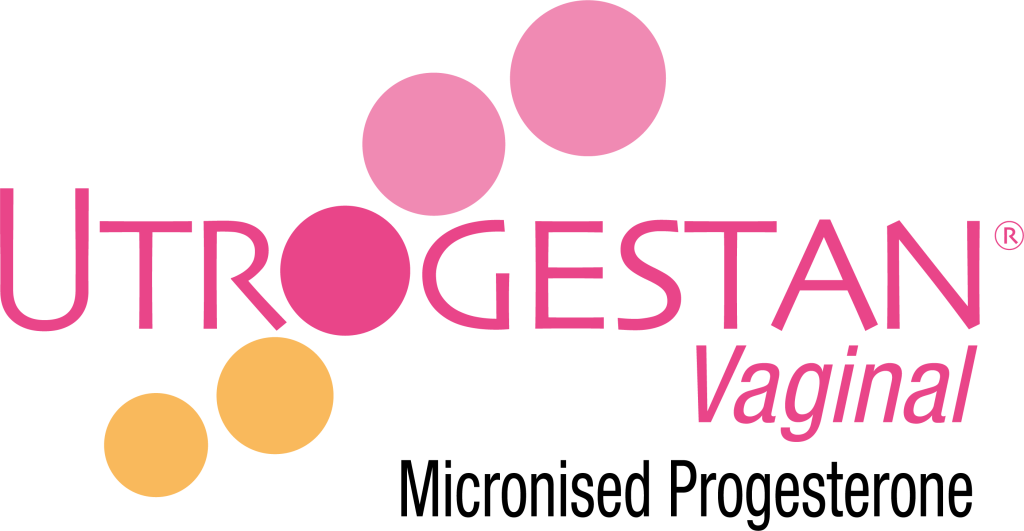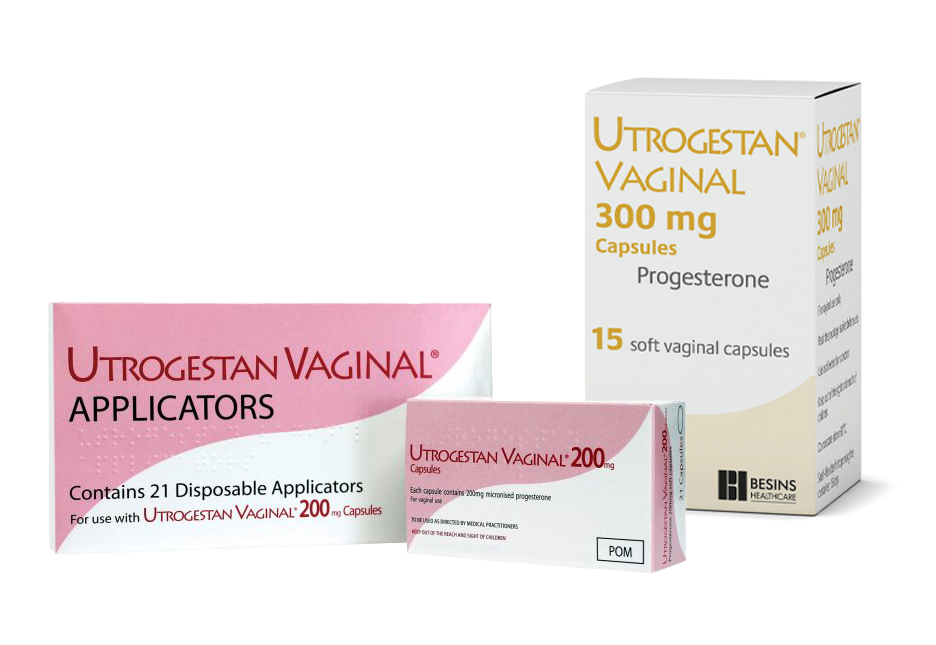
Why have you been prescribed this medicine?
UTROGESTAN VAGINAL
As part of your assisted fertility treatment, the medication you take to control ovulation and the embryo transfer procedure can disrupt your body’s natural progesterone production. This can result in low levels of progesterone.
In the luteal phase (the part of your menstrual cycle after ovulation) progesterone is needed to thicken the uterus wall (called the endometrium), ready for an embryo to implant.
Utrogestan Vaginal contains progesterone and offers ‘luteal phase support’. When inserted into the vagina, progesterone helps increase the chances of successful implantation and pregnancy.
How to use
UTROGESTAN VAGINAL
Always follow the instructions given to you by your doctor.
Before you start:
- Read the package leaflet that comes with your medicine before using it.
- Practice good hygiene and wash your hands before and after inserting Utrogestan Vaginal.
After you have inserted Utrogestan Vaginal
- Wash your hands thoroughly after inserting Utrogestan Vaginal.
- Wearing a panty liner is recommended, as there may be some leakage from the dissolved capsule.
When not to use
UTROGESTAN VAGINAL
Always follow the instructions given to you by your doctor and read the package leaflet that comes with your medicine for a full list of warnings and precautions.
Do not use Utrogestan Vaginal if:
- You are allergic (hypersensitive) to progesterone, soya lecithin, peanut, soya, or to any of the other ingredients of this medicine
- You have severe liver disease
- You have unexplained vaginal bleeding
- You have mammary or genital tract carcinoma
- You have thrombophlebitis
- You have or have had blood clots in a vein (thrombosis), such as in the legs (deep venous thrombosis) or the lungs (pulmonary embolism)
- You have cerebral haemorrhage
- You have a rare blood problem called “porphyria” which is passed down in families (inherited)
- You have had a missed abortion
- You have had premature rupture of membranes (PROM) (Utrogestan Vaginal 200mg ONLY).
Ref: Utrogestan Vaginal 200mg Package Leaflet, Utrogestan Vaginal 300mg Package Leaflet
Precaution
Utrogestan Vaginal must only be administrated by the vaginal route. A complete medical examination must be performed before starting the treatment and regularly during the treatment. Utrogestan vaginal capsules are not suitable as a contraceptive. In rare cases, the use of micronised progesterone during the second and third trimester of pregnancy may lead to the development of gravidic cholestasis or hepatocellular liver disease.
Utrogestan Vaginal contains soya lecithin. As there is a possible relationship between allergy to soya and allergy to peanuts, patients with peanut allergy should avoid using Utrogestan vaginal capsules.
Patient Resources
Please read the package leaflet that comes with your medicine before using Utrogestan Vaginal.
Always use this medicine exactly as your healthcare professional has told you. If you are not sure, you can check with your doctor, pharmacist or nurse.
The Utrogestan Vaginal Package Leaflet provides useful information about your medication, what it is used for and how to use it.
Utrogestan Vaginal 200mg – Click here to download the Package Leaflet PDF
Utrogestan Vaginal 300mg – Click here to download the Package Leaflet PDF
Assisted Reproductive Technology (ART)
ART is the technology used to achieve pregnancy in procedures such as fertility medication, artificial insemination, in vitro fertilisation and surrogacy. It is reproductive technology used primarily for infertility treatments.
Endometrium
The lining of the womb – progesterone makes it thicken during the luteal phase of the menstrual cycle so it can help a fertilised egg develop.
Follicular phase
The Follicular phase is part of the menstrual cycle. It starts on the first day of your menstrual period and ends when you ovulate. During this stage the follicles (pods containing the eggs) ripen, and one of the eggs matures.
Hormone
A natural chemical, normally produced by the body, to help regulate or change one of the body’s systems.
IVF
In vitro fertilisation.
Implantation
When a fertilised egg is placed into the uterus (womb).
Luteal phase
The Luteal phase is part of the menstrual cycle. In this phase, the follicle that released the egg produces hormones that thicken and ripen the endometrium (the inner lining of the uterus) to prepare for pregnancy.
Menstrual cycle
The cycle of ovulation (the luteal and follicular stages) of a woman’s reproductive system that can allow her to become pregnant.
Ovulation
This is the process of the menstrual cycle which results in the release of a mature egg from the ovary. The difference between an IVF cycle and a regular menstrual cycle is that ovulation is artificially induced to mature the eggs and to time their harvesting to enable their fertilisation in the IVF lab.
Progesterone
Progesterone is a hormone which in a regular menstrual cycle is produced by the ovaries. Progesterone prepares the lining of the uterus (endometrium) to allow a fertilised egg (embryo) to stick or implant. In assisted fertility treatment progesterone may not be released by the ovaries and so it is taken as a medication during this procedure.
Shedding
When the walls of the womb break down and are released out of the vagina – what’s commonly known as ‘having your period’.
Uterus
The womb.
What are Utrogestan Vaginal capsules?
Utrogestan Vaginal capsules contain the hormone progesterone, which supports the womb lining during the luteal phase of pregnancy, following IVF treatment.
What is the difference between Utrogestan Vaginal 200mg and 300mg capsules?
Both products deliver 600mg of progesterone each day. Utrogestan Vaginal 200mg is inserted 3 times a day. Utrogestan Vaginal 300mg is inserted 2 times a day and does not come with applicators. Always follow your doctors instructions.
What is progesterone?
Progesterone is a female hormone that’s released naturally as part of the menstrual cycle to help prepare the body for pregnancy.
Why does Utrogestan Vaginal have to be inserted into the vagina?
Inserting Utrogestan Vaginal into the vagina allows the progesterone to be rapidly absorbed.
How to take Utrogestan Vaginal?
Always take Utrogestan Vaginal only as your doctor has told you to.
What if I forget to take a dose of Utrogestan Vaginal?
If you forget a dose, insert a capsule as soon as you remember. If it’s nearly time for the next dose, then skip the dose you’ve forgotten. Do not take a double dose.
Can a Utrogestan Vaginal capsule fall out?
If it is inserted correctly it’s unlikely a capsule will fall out.
How soon can I go to the toilet after inserting Utrogestan Vaginal?
Straight away – the capsules should be inserted deep in your vagina, so going to the toilet (which happens through your urinary canal) won’t affect the capsules.
Ref: Utrogestan Vaginal Package Leaflet 200mg, Utrogestan Vaginal Package Leaflet 300mg
Reporting side effects
If you get any side effects, talk to your doctor, pharmacist or nurse. This includes any possible side effects not listed in the package leaflet.
You can also report side effects directly via the Yellow Card Scheme at www.mhra.gov.uk/yellowcard or search MHRA Yellow Card in the Google Play or Apple App Store. By reporting side effects you can help provide more information on the safety of this medicine.
References:
1. Besins Healthcare (UK) Ltd Utrogestan Vaginal 200mg Package Leaflet. Available from https://www.medicines.org.uk/emc/files/pil.3244.pdf Last accessed: June 2025.
2. Besins Healthcare (UK) Lts Utrogestan Vaginal 300mg Package Leaflet. Available from: https://www.medicines.org.uk/emc/product/15913/pil Last accessed: June 2025
3. Utrogestan Vaginal 200mg Summary of Product Characteristics. Available from: https://www.medicines.org.uk/emc/product/3244/smpc Last accessed: June 2025.
4. Utrogestan Vaginal 300mg Summary of Product Characteristics. Available from: https://www.medicines.org.uk/emc/product/15913/smpc Last accessed: June 2025

